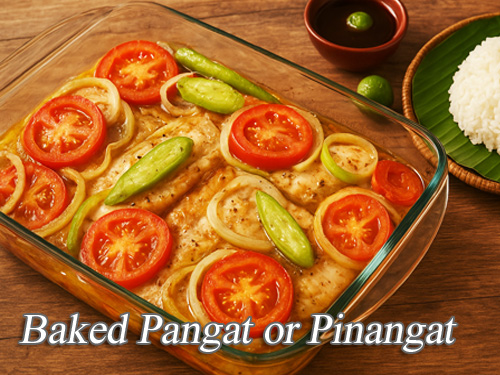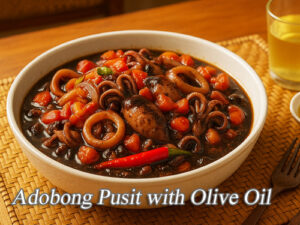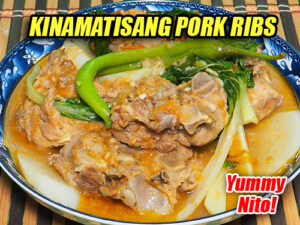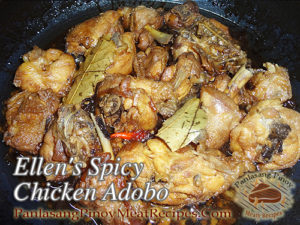Baked pangat is baked fish fillet with olive oil, onions, tomatoes, kamias and spices. Just like pinangat the usual method of cooking is similar but the difference is, this dish is baked and instead of the whole fish, this recipe uses fish fillet. Lapu-lapu and maya-maya fish fillet is a good choice and you don’t need to worry about fish bones because it is already filleted.
Baked Pangat or Pinangat: A Family Twist on a Classic Dish
I first tasted baked pangat one rainy afternoon at my Tita Lorna’s house in Quezon. She always loved experimenting with traditional recipes, adding her own little touches without losing the soul of the dish. Normally, pangat—or pinangat as most of us know it—is simmered gently on the stovetop, often with fresh fish swimming in tomatoes, onions, and kamias for that sharp, tangy flavor we Filipinos can’t resist. But this version was different. Instead of whole fish, she used fillets of lapu-lapu and maya-maya, and instead of simmering, she baked it slowly in the oven. The result was a dish that carried the same comforting flavors of home, yet with a lighter, more elegant feel.
I remember my cousin Joel joking that it felt “sosyal” because it came out of the oven in a pyrex dish, bubbling with olive oil and bright colors from the vegetables. Still, when we sat down and ate it with steaming hot rice, it was just as comforting and familiar as the pangat we grew up with.
Why Bake Instead of Simmer?
At first, I wondered why my aunt chose to bake it when simmering is the traditional way. She explained that baking allows the fish to cook evenly in its own juices, locking in moisture without the constant stirring or watching required on the stovetop. The olive oil keeps the fillets tender, while the oven’s dry heat intensifies the flavors of tomatoes and kamias, giving the dish a slightly roasted depth you can’t get from boiling alone.
It’s a clever method, especially for beginners who might find it tricky to cook fish perfectly on the stovetop. With baking, you just prepare the layers, slide it in the oven, and let the heat do the work. No risk of breaking apart delicate fish flesh or over-reducing the sauce.
Choosing the Right Fish
When my Kuya Danny brought home maya-maya fillets from the market in Lucena, my aunt insisted it was perfect for this dish. Firm and slightly sweet, it holds its shape well even after baking. Lapu-lapu, on the other hand, adds a more delicate flavor that pairs beautifully with the tartness of kamias. What I love most about using fillets is the convenience—no bones to pick through, no mess, just pure enjoyment of the dish.
If you can’t find kamias, you might substitute with calamansi or even green mangoes in a pinch, but for many of us, kamias brings back childhood memories of climbing trees and eating the fruit raw with a dash of salt. Including it in baked pinangat feels like carrying a little piece of that nostalgia straight into the kitchen.
A Taste of History
The word “pinangat” actually comes from the old Tagalog term “pangat,” which means to cook fish in a broth made of sour fruit. It’s a cooking method deeply rooted in our heritage, long before ovens became common in Filipino homes. By baking the dish, we’re not changing its identity but simply adapting it to modern kitchens and busy lifestyles.
In some provinces like Bicol, “pinangat” means something entirely different—taro leaves stewed in coconut milk. That’s the beauty of Filipino food: one word can tell many stories, depending on where you grew up. For me, though, pangat will always be about sour, savory fish simmered in tomatoes and kamias, and now, baked in a way that feels both new and familiar.
How to Cook Baked Pangat at Home
The process is straightforward, which makes it perfect for weeknights. Start by lining a pyrex dish with fresh slices of tomatoes, onions, and kamias. This creates a flavorful bed for the fish. Drizzle in half of the olive oil, then arrange the fillets neatly on top. A light sprinkle of salt and pepper on both sides is all you need—no need to complicate the flavors.
Once the fish is seasoned, add another layer of tomatoes, onions, and kamias, like a colorful blanket sealing in the juices. Pour the remaining olive oil and sprinkle a final pinch of salt. Then bake at 350°F for about 45 minutes, until the fish is tender and the vegetables are melting into a sauce.
The moment you lift the dish from the oven, you’ll be greeted with the aroma of tangy kamias and sweet tomatoes mingling with the richness of olive oil. Serve it hot with steamed rice, and you’ll understand why this baked version deserves a place on the family table.
Comfort Food, Reimagined
Every time I make baked pangat now, I think back to that rainy day at Tita Lorna’s house, when we all gathered around the table and enjoyed something both old and new. It’s a dish that respects tradition while embracing convenience, the kind of recipe you can proudly share with guests or enjoy on a quiet night with family.
Sometimes, food doesn’t just fill our stomachs—it connects us to memories, people, and places. And for me, this simple baked version of pinangat will always be a reminder of home, love, and the beautiful way Filipino dishes continue to evolve without losing their heart.
How to Make Baked Pangat or Pinangat
Ingredients
- 1 kilo lapu-lapu or maya-maya fillets
- 4 pcs big tomatoes sliced into rings
- 3 pcs big onions sliced into rings
- 6 pcs fresh kamias sliced into rings
- 1/2 cup olive oil
- 1 Tbsp. salt
- 1/4 tsp. peppercorns crushed
Instructions
How to cook Baked Pangat or Pinangat
- Line the bottom of a pyrex dish with sliced tomatoes, onions and kamias.
- Pour in half of the olive oil and arrange a layer of fish fillet.
- Sprinkle salt and pepper on both sides.
- Add remaining tomatoes, onions and kamias on top of the fish fillets.
- Sprinkle with salt and the remaining half of the olive oil.
- Bake at 350 °F for 45 minutes or until fish is cooked.
- Serve hot with steamed rice. Serves 6.
Notes
Cooking Tips:
Use Fresh Fish Fillets
Freshness is the secret to a flavorful baked pangat, so choose fillets that are firm, shiny, and have a mild ocean scent. Lapu-lapu and maya-maya are excellent options because they hold their shape well in the oven. Avoid frozen fillets if possible, as thawed fish can become mushy and affect the dish’s texture.Don’t Skip the Kamias
Kamias is the heart of this dish, providing the signature tangy kick that balances the richness of olive oil and fish. If fresh kamias isn’t available, you can use green mango or calamansi, but the flavor won’t be quite the same. Including kamias keeps the dish true to its Filipino roots and makes every bite bright and refreshing.Layer Ingredients Properly
Lining the bottom of the dish with tomatoes, onions, and kamias ensures the fish absorbs all the flavors as it bakes. Adding another layer on top creates a natural seal that keeps the fillets moist and juicy. This technique also allows the vegetables to slowly release their juices, forming a light sauce without needing extra broth.





